

Biconical Antenna AP2000. Electrical characteristics Antenna type: biconical (passive device) Frequency range: from 60 MHz to 2500 MHz Maximum applicable field: > 300 V/m Cross-polar component rejection: > 22 dB Isotropic error: up to 1500 MHz < 0.5 dB from 1500 MHz to 2200 MHz < 0.9 dB from 2200 MHz to 2500 MHz < 1.2 dB Balun symmetry: from 60 MHz to 80 MHz < 0.6 dB from 80 MHz to 2500 MHz < 0.2 dB Physical characteristics.
Sistemi: engineering solutions for aircraft warning lighting. EMF measurement. Electric field probe FP2000 (range 100 kHz – 2500 MHz) EMF probes may respond to fields only on one axis, or may be tri-axial, showing components of the field in three directions at once.
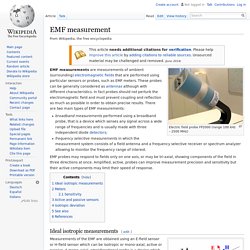
Amplified, active, probes can improve measurement precision and sensitivity but their active components may limit their speed of response. Ideal isotropic measurements[edit] E-field projections on an orthogonal reference frame Using a mono-axial probe implies the need for three measurements taken with the sensor axis set up along three mutually orthogonal directions, in a X, Y, Z configuration. Or, in case of the magnetic field An isotropic (tri-axial) probe simplifies the measurement procedure because the total field value is determined with three measures taken without changing sensor position: this results from the geometry of the device which is made by three independent broadband sensing elements placed orthogonal to each other. International Agency for Research on Cancer. The International Agency for Research on Cancer (IARC; French: Centre international de Recherche sur le Cancer, CIRC) is an intergovernmental agency forming part of the World Health Organization of the United Nations.
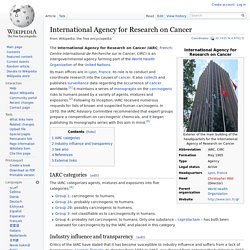
Its main offices are in Lyon, France. Its role is to conduct and coordinate research into the causes of cancer. It also collects and publishes surveillance data regarding the occurrence of cancer worldwide.[1] It maintains a series of monographs on the carcinogenic risks to humans posed by a variety of agents, mixtures and exposures.[2] Following its inception, IARC received numerous requests for lists of known and suspected human carcinogens. In 1970, the IARC Advisory Committee recommended that expert groups prepare a compendium on carcinogenic chemicals, and it began publishing its monographs series with this aim in mind.[3] IARC categories[edit] The IARC categorizes agents, mixtures and exposures into five categories.[4]
Electromagnetic radiation and health. Electromagnetic radiation can be classified into two types: ionizing radiation and non-ionizing radiation, based on its capability of ionizing atoms and breaking chemical bonds.
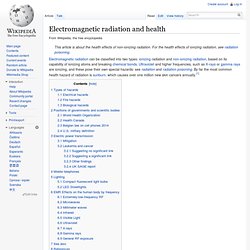
Ultraviolet and higher frequencies, such as X-rays or gamma rays are ionizing, and these pose their own special hazards: see radiation and radiation poisoning. By far the most common health hazard of radiation is sunburn, which causes over one million new skin cancers annually.[1] Types of hazards[edit] Electrical hazards[edit] Very strong radiation can induce current capable of delivering an electric shock to persons or animals. Fire hazards[edit] Extremely high power electromagnetic radiation can cause electric currents strong enough to create sparks (electrical arcs) when an induced voltage exceeds the breakdown voltage of the surrounding medium (e.g. air).
This can be a particular hazard in the vicinity of explosives or pyrotechnics, since an electrical overload might ignite them. Radiation - Environment and Workplace Health. Radiation is energy that comes from a source and travels through material or space.
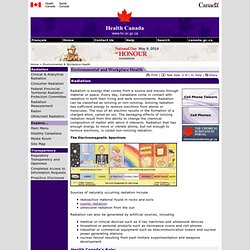
Every day, Canadians come in contact with radiation in both their living and work environments. Radiation can be classified as ionizing or non-ionizing. Ionizing radiation has sufficient energy to remove electrons from atoms or molecules. The loss of an electron results in the formation of a charged atom, called an ion. The damaging effects of ionizing radiation result from this ability to change the chemical composition of matter with which it interacts. The Electromagnetic Spectrum. Radiation Measurement - Environmental and Workplace Health. Health Canada www.hc-sc.gc.ca Home > Environmental & Workplace Health > Radiation Ionizing radiation is a part of Canada's environment.
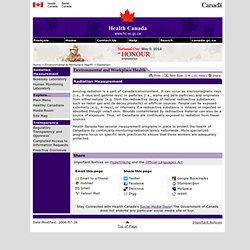
It can occur as electromagnetic rays (i.e., X-rays and gamma rays) or particles (i.e., alpha and beta particles) and originates from either natural (e.g. from the radioactive decay of natural radioactive substances such as radon gas and its decay products) or artificial sources. People can be exposed externally (e.g., X-rays), or internally if a radioactive substance is inhaled or ingested or absorbed through intact skin. Health Canada has several measurement programs in place to protect the health of Canadians by continually monitoring radiation levels nationwide. Stay Connected with Health Canada's Social Media Tools! About the Center for Devices and Radiological Health.
National Council on Radiation Protection & Measurements (NCRP) - Radiation Exposure Data, Radiation Protection Guidelines. National Council on Radiation Protection & Measurements (NCRP) - Radiation Exposure Data, Radiation Protection Guidelines. EMF Detector DT-1130. James P. O'Loughlin. 6587729. Online references. Sitemap. INTERNATIONAL AGENCY FOR RESEARCH ON CANCER. Planning and developing population-based cancer registration in low- and middle-income settings (as an e-Book) 09/09/2014 Guidelines for establishing cancer registries, from the International Agency for Research on Cancer (IARC), the World Health Organization (WHO), and the International Association of Cancer Registries (IACR), are now available free in EPUB format.
IARC Technical Publication No. 43, entitled "Planning and developing population-based cancer registration in low- and middle-income settings", provides essential guidance on the key steps in planning a registry, including accessing sources of information, monitoring the quality of the data, and reporting results. IARC introduced e-books in 2013 as a new medium for the wider dissemination of the Agency's research.
This publication is also available in print and PDF formats. The International EMF Project.